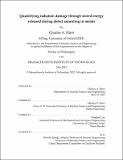Quantifying radiation damage through stored energy released during defect annealing in metals
Author(s)
Hirst, Charles A.
DownloadThesis PDF (38.39Mb)
Advisor
Short, Michael P.
Terms of use
Metadata
Show full item recordAbstract
With full knowledge of a material’s atomistic structure, it is possible to predict any macroscopic property of interest. In practice, this is hindered by limitations of the chosen characterisation technique. For example, transmission electron microscopy (TEM) is unable to detect the smallest and most numerous defects in irradiated metals. Instead of spatial characterisation, defects can be detected and quantified through their excess energy.
Previous measurements of stored energy in irradiated metals have been limited to cryogenic or ambient temperatures, despite nuclear reactors operating at 300◦C and above. Differential scanning calorimetry (DSC) of reactor-irradiated Ti measures defect densities 5 times greater than those determined using TEM. These experiments also reveal two energetically-distinct processes where the established annealing model predicts one. Molecular dynamics (MD) simulations discover the defects responsible and show that the point defect induced glide of dislocation loops contributes significantly to recovery. Our characterisation techniques are combined to propose a new mechanism for the recovery of irradiation-induced defects at elevated temperatures.
In order to probe even smaller quantities of released energy, advances in chipbased nanocalorimetry are investigated. Flash DSC experiments demonstrate the measurement of sample mass to within 1 ng. MD simulations are used to predict the maximum possible stored energy release from Al electron-irradiated at cryogenic temperatures. Extrapolation across 11 orders of magnitude in time and 18 orders of magnitude in mass yields results which match prior literature within a factor of 2. These results are combined with measurements of the noise, as characterised through the power spectral density, to determine whether the Flash DSC can be used to detect defect annealing in irradiated metals.
Date issued
2022-05Department
Massachusetts Institute of Technology. Department of Nuclear Science and EngineeringPublisher
Massachusetts Institute of Technology